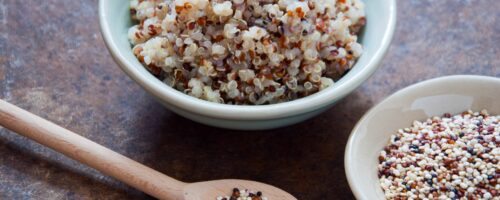
安第斯山脉
How is it produced?
Gluten free products like quinoa are increasing popularity. Quinoa is a gluten free grain that does not belong to the leafy grain grass family like wheat, corn, barley, oats and other cereals, therefore making it popular with those who have allergies, and are using it as a healthy alternative.
Quinoa has been cultivated in the mountain regions or salt flats of Peru, Ecuador and Bolivia for more than 3,000 years. And those three countries remain the largest exporters of the product today. Today, thanks to quinoa, farmers in the Andes of South America enjoy higher incomes, which would help lift a lot of people out of extreme poverty. According to The International Trade Centre, the value of global quinoa exports rose by more than 235% between 2013 and 2015, from $135.53m to $321.56m. But the problem that growing quinoa caused emerges. With the increasing price and demand of quinoa in the international market, there are concerns of land conflicts and loss of biodiversity as farmers turned to monocropping and abandoned traditional, sustainable farming practices to keep up with increased demand. Those concerns are real: traditionally, lands used for quinoa production are rotated with a variety of crops and are fertilized by manure from llama herds. This traditional practice protect the integrity of the soil, keeping it nutrient-rich and preventing erosion. But now, in order to produce higher yields and make more profit,
farmers are doing the opposite, they sold their llamas, stopped crop rotations and no long respect ‘rest’ periods for the land to recover. The result will be harsh— soil quality worsen year by year which increase erosions and desertification. Farmers will soon be faced with the harsh reality that land is finite.
Describe the supply chain to the store shelf in Canada:
Farmers in those developing countries does improved their living standards via growing quinoa, but actually they only gets the smallest portion of benefit in the international market, even if they pay for the price for destroying their ecosystem.
Last September, Organic & Wellness News took part in a press mission to Ecuador that included visiting organic projects, quinoa farmer cooperatives from Riobamba among them. The cooperatives receive 39 cents/lb for organic quinoa. Back in Canada on a trip to a local grocery store chain in Ottawa, Adriana Michael, publisher of Organic & Wellness News, discovered organic quinoa from Bob’s Red Mill, a US based wholesaler who buys the organic quinoa from cooperatives in Ecuador, via Importer Inca Organics. The quinoa package of 725 grms on the retail shelf had a price tag of 8,99 CAD ($8,89 US).
What is the power balance between the producer and seller?
Surprised of the difference in price from producer to end consumer for a product with no significant added value, Michael wondered what the costs were along the distribution chain, and if the system and price structure is fair to farmers and consumers? The origin of for-sale quinoa is from Coprobich, a cooperative, which consist of 3,000 quinoa farmers. The cooperative sells quinoa to Sumak Life, a nonprofit facility which cleans and packages the quinoa in Ecuador and pays the fees for organic and fair trade certifications. Sumak Life receives 26 cents/lb to clean and process the quinoa. Then the organic certified harvest goes to the UK and the U.S. After arriving at the U.S, owners of Inca Organics in the U.S. buy the quinoa for 0.70 cents/lb from Sumak Life. They then sell the quinoa to distributors such as wholesaler Bob’s Red Mill at 0.87 cents/lb. Inca Organics pays for shipping to port, shipping to USA, England and Canada, insurance and warehousing. The quinoa enjoys duty-free status. Bob’s Red Mill Natural Food’s quinoa sells for 8.99 CAD (8.89 US) for 725 grams at Canada’s retail stores. Taken together the wholesaler, distributors and retailer have created over a 600% mark-up. The farmer receives approximately 7 % of the profit.
Can you recommend changes to the system to improve the balance?
There are two suggestions for farms growing quinoa in the south America that would increase their competitivity in the international market.
First, they have to make quinoa a sustainable crop for them rather than “a temporary wealth”. What this means is that they should make sure their land could harvest quinoa in the long term. To do this, quinoa have to be sustainable, farmers, governments, cooperatives and quinoa companies must embrace traditional farming practices that respect crop rotation, biodiversity, land held in common and ‘rest’ periods for the land. We know quinoa has the potential to be farmed sustainably because it already has been, and many small farmers continue to do so.
Second, making quinoa has a higher earning potential for farmers in the global market. Two initiatives can be taken in this regard; One, shortening the distance between farmers and consumers and avoid distributors that elevate the final cost for retailers. Two, diversifying the products made of quinoa; Bernardo Peña M, a quinoa farmer and processor at family business Porges, near Pujili, Ecuador, said he is finding alternative to make his product more attracting to global buyers. “Now we make added-value products.” said him. “Ten years ago you just think about [putting quinoa in] soup. But now it is in cake, biscuits and many things – you go into the supermarket and there are now 10 products on the shelf.” Porges now produces quinoa shakes, breakfast cereals and chocolate bars using quinoa. According to government trade body Pro-Ecuador, Ecuador now exports added-value quinoa products that include compotes and snacks. In 2016, the country exported 1,620 tonnes worth USD $4.8m, with the majority going to the USA, Canada, Germany, Israel and France.
References/Resources:
Caitlan Hester. Is Quinoa Sustainable? The Surprising Facts (Study-Based)
https://citizensustainable.com/quinoa-sustainable/#Environmental_Side-Effects
Ed Stocker (2013). Quinoa: Good for you – bad for Bolivians
ADAMA (2018). Quinoa: How the super food boom is impacting Ecuador’s farmers
Leah Dobkin. Are prices fair along quinoa’s supply chain?
http://leahdobkin.com/articles/supplychain.pdf
SBBC Importing Trends: Quinoa and Coconut

